Leptis Magna
Leptis or Lepcis Magna, also known by other names in antiquity, was a prominent city of the Carthaginian Empire and Roman Libya at the mouth of the Wadi Lebda in the Mediterranean.
_(8288918733).jpg.webp) | |
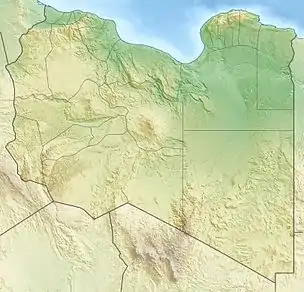 Shown within Libya | |
| Alternative name | Lepcis Magna, Neapolis, Lpqy |
|---|---|
| Location | Khoms, Libya |
| Region | Tripolitania |
| Coordinates | 32°38′21″N 14°17′26″E |
| Type | Settlement |
| History | |
| Founded | 1000 BC[1] |
| Abandoned | 7th c. AD |
| Periods | Iron Age to Byzantine |
| Cultures | Carthaginian Roman |
| Official name | Archaeological Site of Leptis Magna |
| Type | Cultural |
| Criteria | i, ii, iii |
| Designated | 1982 (6th session) |
| Reference no. | 183 |
| Region | North Africa |
Originally founded by a group of local Berbers in 1000 BC,[2] it was greatly expanded under Roman Emperor Septimius Severus (r. 193–211), who was born in the city. The 3rd Augustan Legion was stationed here to defend the city against Berber incursions. After the legion's dissolution under Gordian III in 238, the city was increasingly open to raids in the later part of the 3rd century. Diocletian reinstated the city as provincial capital, and it grew again in prosperity until it fell to the Vandals in 439. It was reincorporated into the Eastern Empire in 533 but continued to be plagued by Berber raids and never recovered its former importance. It fell to the Muslim invasion in c. 647 and was subsequently abandoned.
Its ruins are within present-day Khoms, Libya, 130 km (81 mi) east of Tripoli. They are among the best-preserved Roman sites in the Mediterranean.
Names
The Punic name of the settlement was written LPQ (Punic: 𐤋𐤐𐤒) or LPQY (𐤋𐤐𐤒𐤉).[3][4][5] This has been tentatively connected to the Semitic root (present in Arabic) LFQ, meaning "to build" or "to piece together", presumably in reference to the construction of the city.[6]
This name was hellenized as Léptis (Ancient Greek: Λέπτις),[7] also known as Léptis Megálē (Λέπτις μεγάλη, "Greater Leptis") distinguishing it from the "Lesser Leptis" closer to Carthage in modern-day Tunisia. It was also known by the Greeks as Neápolis (Νεάπολις, "New Town"). The latinization of these names was Lepcis or Leptis Magna ("Greater Leptis"), which also appeared as the "Leptimagnese City" (Latin: Leptimagnensis Civitas). The Latin demonym was "Leptitan" (Leptitanus). It was also known as Ulpia Traiana as a Roman colony.[5] Its Italian name is Lepti Maggiore, and in Arabic it is named Labdah (لَبْدَة).[8][9]
History
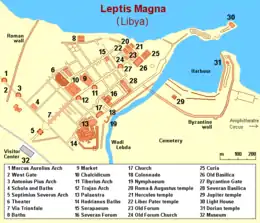
Phoenicians
The Phoenician city was founded in the second half of the 7th century BC. Little is known about Leptis during this time, but it appears to have been powerful enough to repel Dorieus's attempt to establish a Greek colony nearby around 515 BC.[4] Like most western Phoenician settlements, Leptis became part of the Carthaginian Empire and fell under Rome's control with Carthage's defeat in the Punic Wars. Leptis remained highly independent for a period after about 111 BC.
Roman Republic
The Roman Republic sent some colonists together with a small garrison in order to control the city. The city prospered and was even allowed to coin its own money in silver and bronze. Reflecting its blend of cultures, its coins bore Punic inscriptions but images of Hercules and Dionysus.[5] Soon Italian merchants settled in the city and started a profitable commerce with the Libyan interior.[10] The city depended primarily on the fertility of its surrounding farmland, where many olive-presses have been excavated. By 46 BC, its olive oil production was of such an extent that the city was able to provide three million pounds of oil annually to Julius Caesar as tax.[4]
Roman Empire
Kenneth D. Matthews, Jr. writes:[11]
During the reign of Augustus, Leptis Magna was classified as a civitas libera et immunis, or a free community, over which the governor had an absolute minimum of control. As such Leptis retain its two suphetes at the head of its government, with the mhzm, similar to the Roman aediles, as minor magistrates. In addition there were such sacred officials as the ʾaddir ʾararim or praefectus sacrorum, the nēquim ēlīm, and probably a sacred college of fifteen members.
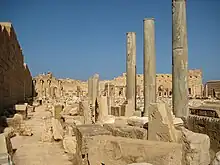
Leptis Magna remained as such until the reign of the Roman emperor Tiberius, when the city and the surrounding area were formally incorporated into the empire as part of the province of Africa. It soon became one of the leading cities of Roman Africa and a major trading post. The city grew rapidly under Roman administration. During the reign of Nero, an amphitheater was constructed. The settlement was elevated to municipium in AD 64 or 65 and to colonia under Trajan (r. 98–117)
Leptis achieved its greatest prominence beginning in AD 193, as the hometown of emperor Septimius Severus. Septimius favored his hometown above all other provincial cities, and the buildings and wealth he lavished on it made Leptis Magna the third-most important city in Africa, rivaling Carthage and Alexandria. In AD 205, he and the imperial family visited the city and bestowed great honors. Among the changes that Severus introduced were the creation of a magnificent new forum and the rebuilding of the docks. The natural harbor had a tendency to silt up, but the Severan changes made this worse, and the eastern wharves are extremely well preserved, since they were scarcely used.
Leptis overextended itself during this period. During the Crisis of the 3rd Century, when trade declined precipitously, Leptis Magna's importance also fell into a decline, and by the middle of the 4th century, even before it was completely devastated by the 365 tsunami, large parts of the city had been abandoned. Ammianus Marcellinus recounts that the crisis was worsened by a corrupt Roman governor named Romanus, who demanded bribes to protect the city during a major tribal raid. The ruined city could not pay these and complained to the emperor Valentinian I. Romanus then bribed people at court and arranged for the Leptan envoys to be punished "for bringing false accusations". It enjoyed a minor renaissance beginning in the reign of the emperor Theodosius I.
Vandal Kingdom
In 439, Leptis Magna and the rest of the cities of Tripolitania fell under the control of the Vandals when their king, Gaiseric, captured Carthage from the Romans and made it his capital. Unfortunately for the future of Leptis Magna, Gaiseric ordered the city's walls demolished so as to dissuade its people from rebelling against Vandal rule. The people of Leptis and the Vandals both paid a heavy price for this in AD 523 when a group of Berber raiders sacked the city.
Byzantine Empire
Belisarius, general of Emperor Justinian I, recaptured Leptis Magna in the name of the Roman Empire ten years later, and in 533–4 it was re-incorporated into the empire. Leptis became a provincial capital of the Eastern Empire, but never recovered from the destruction wreaked upon it by the Berbers. In 544, under the prefecture of Sergius, the city came under intensified attack of Berber tribes, and after some successes, Sergius was reduced to retreating into the city, with the Leuathae tribal confederation camped outside the gate demanding payments. Sergius admitted eighty deputies into the city to present their demands, but when Sergius moved to leave the conference he was detained by the robe by one deputy and crowded by others. This provoked an officer of the prefect's guard to kill the deputy laying hands on the prefect, which resulted in a general massacre. The Berbers reacted with an all-out attack and Sergius was eventually forced to abandon Leptis and retreat to Carthage.[12]
Islamic conquest
By the 6th century, the city was fully Christianized.[13] During the decade 565–578 AD Christian missionaries from Leptis Magna even began to move once more among the Berber tribes as far south as the Fezzan in the Libyan desert and converted the Garamantes.[14] Numerous new churches were built in the 6th century,[15] but the city continued to decline, and by the time of the Arab conquest around 647 the city was mostly abandoned except for a Byzantine garrison force and a population of less than 1,000 inhabitants. By the 10th century, the city of Al-Khums had fully absorbed it.[16]
Excavation
Today, the site of Leptis Magna is the site of some of the most impressive ruins of the Roman period.
_(geograph_3935706).jpg.webp)
Part of an ancient temple was brought from Leptis Magna to the British Museum in 1816 and installed at the Fort Belvedere royal residence in England in 1826. It now lies in part of Windsor Great Park.[17] The ruins are located between the south shore of Virginia Water and Blacknest Road close to the junction with the A30 London Road and Wentworth Drive.

When Italians conquered Italian Libya in the early 20th century, they dedicated huge efforts to the rediscovery of Leptis Magna. In the early 1930s Italian archeological research was able to show again the buried remains of nearly all the city.[18] A 4th to 3rd century BC necropolis was found under the Roman theatre.
In June 2005, it was revealed that archaeologists from the University of Hamburg had been working along the coast of Libya when they uncovered a 30 ft length of five colorful mosaics created during the 1st or 2nd century. The mosaics show with exceptional clarity depictions of a warrior in combat with a deer, four young men wrestling a wild bull to the ground, and a gladiator resting in a state of fatigue and staring at his slain opponent. The mosaics decorated the walls of a cold plunge pool in a balneae within a Roman villa at Wadi Lebda in Leptis Magna. The gladiator mosaic is noted by scholars as one of the finest examples of representational mosaic art ever seen—a "masterpiece comparable in quality with the Alexander Mosaic in Pompeii." The mosaics were originally discovered in the year 2000 but were kept secret in order to avoid looting. They are currently on display in the Leptis Magna Museum.[19]
There were reports that Leptis Magna was used as a cover for tanks and military vehicles by pro-Gaddafi forces during the First Libyan Civil War in 2011.[20] When asked about the possibility of conducting an air-strike on the historic site, NATO refused to rule out the possibility of such an action saying that it had not been able to confirm the rebels' report that weapons were being hidden at the location.[21] Shortly after the war, Libyan archaeologist Hafed Walda reported that Leptis Magna, along with nearby Rasaimergib Fort and the western Tripolis of Sabratha, had "so far seen no visible loss" from either fighting on the ground or bombings conducted by international forces.[22]
In the midst of the Second Libyan Civil War and the disappearance of governmental and international support for the site, people living in the area organized to voluntarily protect and maintain Leptis Magna.[23][24]
Climate change
Since they are located on the coast, Leptis Magna ruins are vulnerable to sea level rise. In 2022, the IPCC Sixth Assessment Report included them in the list of African cultural sites which would be threatened by flooding and coastal erosion by the end of the century, but only if climate change followed RCP 8.5, which is the scenario of high and continually increasing greenhouse gas emissions associated with the warming of over 4 °C.[25], and is no longer considered very likely.[26][27] The other, more plausible scenarios result in lower warming levels and consequently lower sea level rise: yet, sea levels would continue to increase for about 10,000 years under all of them.[28] Even if the warming is limited to 1.5 °C, global sea level rise is still expected to exceed 2–3 m (7–10 ft) after 2000 years (and higher warming levels will see larger increases by then), consequently exceeding 2100 levels of sea level rise under RCP 8.5 (~0.75 m (2 ft) with a range of 0.5–1 m (2–3 ft)) well before the year 4000. Thus, it is a matter of time before the Leptis Magna ruins are threatened by rising water levels, unless they can be protected by adaptation efforts such as sea walls.[29]
Gallery
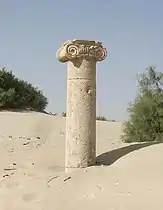 Some of Leptis Magna yet to be excavated
Some of Leptis Magna yet to be excavated.jpg.webp) Market place
Market place Amphitheater
Amphitheater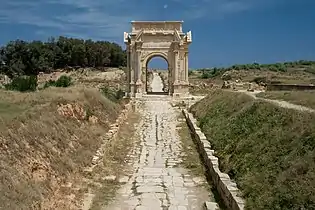 Arch of Septimius Severus
Arch of Septimius Severus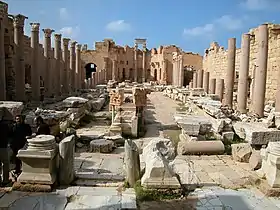 Severan Basilica
Severan Basilica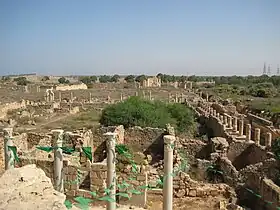 View on Leptis Magna from the theater wall
View on Leptis Magna from the theater wall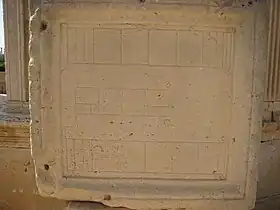 Measure converter, Market (founded 8 or 9 BC) (Phoenician colony)
Measure converter, Market (founded 8 or 9 BC) (Phoenician colony) Decorative columns inside Basilica of Septimius Severus
Decorative columns inside Basilica of Septimius Severus Angling in the 1st century CE. Villa of the Nile Mosaic, Leptis Magna, Tripoli National Museum
Angling in the 1st century CE. Villa of the Nile Mosaic, Leptis Magna, Tripoli National Museum
See also
References
Citations
- https://archiqoo.com/locations/leptis_magna.php
- https://archiqoo.com/locations/leptis_magna.php
- Ghaki (2015), p. 67.
- Brogan & Wilson (2012).
- Head (1911).
- Lipiński (2004), p. 345.
- Strabo, Geography, §17.3.18.
- "لَبْدَة, Libya". National Geospatial-Intelligence Agency. 30 June 2006. Archived from the original on 2020-05-23 – via Geographic.org.
- Leptis Magna at the Encyclopædia Britannica
- Bullo (2002), pp. 167–171.
- Matthews (1957), p. 37.
- Beechey & Beechey (1828), pp. 54–56.
- Mommsen (1909), Chapter XIII. The African Provinces.
- Prevost (2007), pp. 462–463.
- Livius.org, Photos: Lepcis Magna, Byzantine Church.
- Bullo (2002), pp. 185–188.
- The Atlantic, 10 January 2018.
- Musso (2010).
- The Times, 13 June 2005.
- The Times, 14 June 2011.
- CNN, 14 June 2011.
- AP, 4 November 2011.
- AFP, 23 December 2016.
- Reuters, 28 November 2017.
- Trisos, C.H., I.O. Adelekan, E. Totin, A. Ayanlade, J. Efitre, A. Gemeda, K. Kalaba, C. Lennard, C. Masao, Y. Mgaya, G. Ngaruiya, D. Olago, N.P. Simpson, and S. Zakieldeen 2022: Chapter 9: Africa. In Climate Change 2022: Impacts, Adaptation and Vulnerability [H.-O. Pörtner, D.C. Roberts, M. Tignor, E.S. Poloczanska, K. Mintenbeck, A. Alegría, M. Craig, S. Langsdorf, S. Löschke,V. Möller, A. Okem, B. Rama (eds.)]. Cambridge University Press, Cambridge, United Kingdom and New York, NY, US, pp. 2043–2121
- Hausfather, Zeke; Peters, Glen (29 January 2020). "Emissions – the 'business as usual' story is misleading". Nature. 577 (7792): 618–20. Bibcode:2020Natur.577..618H. doi:10.1038/d41586-020-00177-3. PMID 31996825.
- Hausfather, Zeke; Peters, Glen (20 October 2020). "RCP8.5 is a problematic scenario for near-term emissions". PNAS. 117 (45): 27791–27792. doi:10.1073/pnas.2017124117. PMC 7668049.
- Technical Summary. In: Climate Change 2021: The Physical Science Basis. Contribution of Working Group I to the Sixth Assessment Report of the Intergovernmental Panel on Climate Change (PDF). IPCC. August 2021. p. TS14. Retrieved 12 November 2021.
- IPCC, 2021: Summary for Policymakers. In: Climate Change 2021: The Physical Science Basis. Contribution of Working Group I to the Sixth Assessment Report of the Intergovernmental Panel on Climate Change [Masson-Delmotte, V., P. Zhai, A. Pirani, S.L. Connors, C. Péan, S. Berger, N. Caud, Y. Chen, L. Goldfarb, M.I. Gomis, M. Huang, K. Leitzell, E. Lonnoy, J.B.R. Matthews, T.K. Maycock, T. Waterfield, O. Yelekçi, R. Yu, and B. Zhou (eds.)]. Cambridge University Press, Cambridge, United Kingdom and New York, NY, US, pp. 3−32, doi:10.1017/9781009157896.001.
Bibliography
- Alberge, Dalya (13 June 2005). "Roman mosaic 'worthy of Botticelli'". The Times. Retrieved 2020-08-31.
- Alberge, Dalya (13 June 2005). "Roman mosaic "worthy of Botticelli"". The Times – via The Roman Hideout.
- Beechey, Frederick William; Beechey, Henry William (1828). Proceedings of the Expedition to Explore the Northern Coast of Africa, from Tripoly Eastward; in MDCCCXXI and MDCCCXXII. Comprehending an Account of the Greater Syrtis and Cyrenaica; and of the Ancient Cities Composing the Pentapolis. London: John Murray. OCLC 719432955.
- Brogan, Olwen Phillis Frances; Wilson, R. J. A. (2012). "Lepcis Magna". In Hornblower, Simon; Spawforth, Antony; Eidinow, Esther (eds.). The Oxford Classical Dictionary (4th ed.). Oxford & New York: Oxford University Press. p. 821. ISBN 9780199545568.
- Bullo, Silvia (2002). Provincia Africa. Le città e il territorio dalla caduta di Cartagine a Nerone [Province of Africa: The Cities and the Territory from the Fall of Carthage to Nero]. Le Rovine Circolari, 4 (in Italian). Rome: L'Erma di Bretschneider. ISBN 9788882651688.
- Coghlan, Tom (14 June 2011). "Wonder of the Ancient World at risk as Gaddafi uses ruins to hide deadly rockets". The Times. Archived from the original on 2020-08-31.
- Cooper, Paul (10 January 2018). "How Ancient Roman Ruins Ended Up 2,000 Miles Away in a British Garden". The Atlantic. Archived from the original on 2019-12-23.
- D'Emilio, Frances (4 November 2011). "Expert: NATO raids spared Libyan antiquities". The San Diego Union-Tribune. Associated Press. Archived from the original on 2020-08-31.
- De Miro, Ernesto; Polito, Antonella (2005). Leptis Magna. Dieci anni di scavi archeologici nell area del Foro Vecchio. I livelli fenici, punici e romani [Leptis Magna: Ten Years of Archaeological Excavations in the Area of the Old Forum. The Phoenician, Punic and Roman Levels.]. Quaderni di Archeologia della Libya, 19 (in Italian and Arabic). Rome: L'Erma di Bretschneider. ISBN 9788882653095.
- Floriani Squarciapino, Maria (1966). Leptis Magna. Ruinenstädte Nordafrikas, 2 (in German). Basel: Raggi Verlag. OCLC 625443.
- Ghaki, Mansour (2015). "Toponymie et onomastique. L'apport de l'ecriture punique neopunique" [Toponymy and Onomastics: The Contribution of Neopunic Punic Writing] (PDF). In Di Tolla, Anna Maria (ed.). La lingua nella vita e la vita della lingua. Itinerari e percorsi degli studi berberi. Miscellanea per il Centenario di studi berberi a "L'Orientale" di Napoli. Scritti in onore di Francesco Beguinot [Language in Life and the Life of Language: Routes and Paths of Berber Studies. Miscellany for the Centenary of Berber Studies at "L'Orientale" in Naples: Written in Honor of Francesco Beguinot.]. Studi Africanistici: Quaderni di Studi Berberi e Libico-Berberi, 4 (in French). Naples: Unior. pp. 65–71. ISBN 9788867191253. Retrieved 2020-08-31 – via Academia.edu.
- Head, Barclay; et al. (assisted by G. F. Hill, George MacDonald, and W. Wroth) (1911). "Syrtica". Historia Numorum (2nd ed.). Oxford: Clarendon Press. p. 875 – via Digital Historia Numorum, ed. Ed Snible.
- Kreikenbom, Detlev (2007). "Leptis Magna vor der arabischen Eroberung" [Leptis Magna Before the Arab Conquest]. In Kreikenbom, Detlev; Muth, Franz-Christoph; Thielmann, Jörn (eds.). Arabische Christen – Christen in Arabien [Arab Christians – Christians in Arabia]. Nordostafrikanisch-Westasiatische Studien, 6 (in German). Frankfurt am Main & New York: Peter Lang. pp. 35–54. ISBN 9783631550403.
- Lamloun, Imed (23 December 2016). "The unlikely saviors of Libya's Roman remains". The Daily Star. Agence France-Presse. Archived from the original on 2020-08-31.
- Lendering, Jona (13 August 2020). "Lepcis Magna". Livius.org. Archived from the original on 2020-08-31.
- Lewis, Aidan (28 November 2017). "Famed Libyan ruins rely on locals for support". Reuters. Archived from the original on 2018-12-21.
- Lipiński, Edward (2004). Itineraria Phoenicia. Orientalia Lovaniensia Analecta, 127; Studia Phoenicia, 18. Leuven; Paris; Dudley, MA: Uitgeverij Peeters en Departement Oosterse Studies. ISBN 9789042913448.
- Matthews, Kenneth D. Jr. (1957). Cities in the Sand: Leptis Magna and Sabratha in Roman Africa. Photographs by Alfred W. Cook. Philadelphia: University of Pennsylvania Press. OCLC 414295.
- Mattingly, D. J. (2000). "Map 35: Tripolitana". In Talbert, Richard J. A. (ed.). Barrington Atlas of the Greek and Roman World. Princeton, NJ: Princeton University Press. ISBN 9780691031699.
- Mommsen, Theodor (1909) [1886]. The Provinces of the Roman Empire from Caesar to Diocletian. Vol. 2. Translated by Dickson, William P. (Corrected ed.). London: Macmillan. OCLC 4308504.
- Musso, Luisa (2010). Contributions by Daniela Baldoni, Barbara Bianchi, Maria Gloria Calì, Barbara Davidde, Ginette Di Vita-Evrard, Massimiliano Munzi, Roberto Petriaggi, Beatrice Pinna Caboni, Gianni Ponti & Ramadan Shebani. "Missione archeologica dell'Università Roma Tre, 1998-2007" [Archaeological Mission of Roma Tre University, 1998-2007] (PDF). The Department of Archaeology of Libya. Libya Antiqua (in English and Italian). Pisa & Rome: Fabrizio Serra Editore. N.S., vol. V: 49–78. OCLC 4221464. Retrieved 2020-08-31 – via Academia.edu.
- Prevost, Virginie (2007). "Les dernières communautés chrétiennes autochtones d'Afrique du Nord" [The Last Native Christian Communities of North Africa]. Revue de l'histoire des religions (in French). 224 (4): 461–483. doi:10.4000/rhr.5401. JSTOR 23618252.
- Robin, Daniel (2010). This Holy Seed: Faith, Hope and Love in the Early Churches of North Africa (2nd ed.). Chester: Tamarisk Publications. ISBN 9780953856534.
- Strabo (1903) [1854]. The Geography of Strabo. Bohn's Classical Library. Vol. 3 vols. Translated by Hamilton, H. C.; Falconer, W. London: George Bell & Sons. OCLC 250411.
- Swails, Brent; Ward, Damien; Perez Maestro, Laura; Abdelaziz, Salma; Pleitgen, Frederik & Khadder, Kareem (14 June 2011). "South African president blasts NATO actions in Libya". CNN. Archived from the original on 2020-06-14.
- Tomlinson, R. A. (1993). "Lepcis Magna". From Mycenae to Constantinople: The Evolution of the Ancient City. London & New York: Routledge. pp. 191–202. ISBN 9780203412909.
Further reading
- Babelon, E.C.F. (1911). . Encyclopædia Britannica. Vol. 16 (11th ed.). p. 482.
- Bianchi Bandinelli, Ranuccio; Vergara Caffarelli, Ernesto; Caputo, Giacomo (1966). The Buried City: Excavations at Leptis Magna. Photographs by Fabrizio Clerici. New York: F. A. Praeger. OCLC 670109.
- Draper, Robert (February 2013). "New Old Libya". National Geographic. Photographs by George Steinmetz. Archived from the original on 2020-08-30.
- Huß, Werner; Niemeyer, Hans Georg (2006). "Leptis Magna". In Cancik, Hubert; Schneider, Helmuth; Salazar, Christine F. (eds.). Brill's New Pauly: Encyclopaedia of the Ancient World. Antiquity. Vol. 7. Leiden: Brill. doi:10.1163/1574-9347_bnp_e701890. ISBN 9789004122598.
- Smith, Gemma (February 2013). "Archaeologists, propaganda and the military: Libya's cultural heritage and the role of archaeologists in a political crisis". The Post Hole. Department of Archaeology, University of York (27). Archived from the original on 2020-07-16.
- Ward-Perkins, J. B. (1993). Kenrick, Philip (ed.). The Severan Buildings Of Lepcis Magna: An Architectural Survey (PDF). Society for Libyan Studies Monograph, 2. With a contribution by Barri Jones and Roger Ling; architectural drawings prepared and edited by R. Kronenburg. London: The Society for Libyan Studies, on behalf of the Department of Antiquities, Tripoli, SPLAJ. ISBN 9780950836362. Retrieved 2020-08-31.
External links
- Lepcis Magna - The Roman Empire in Africa, documenting the archaeological site and excavations undertaken in the 1990s, including teams from King's College London and the UCL Institute of Archaeology
- Lepcis Magna article on Livius.org
- Lepcis (Leptis) Magna Images, a gallery of photographs taken at the site in February 2008
- Neapolis/Lepcis Magna on Pleiades, a collaborative scholarly gazetteer to the ancient world
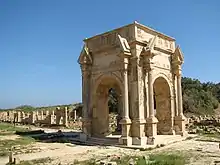
%252C_Algeria_04966r.jpg.webp)